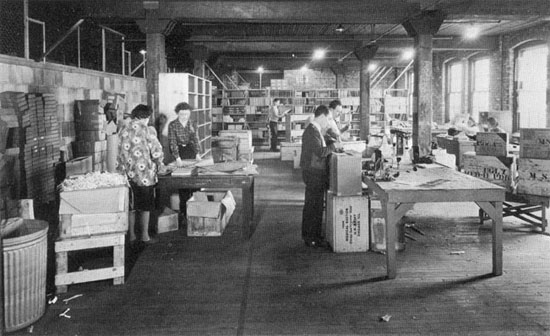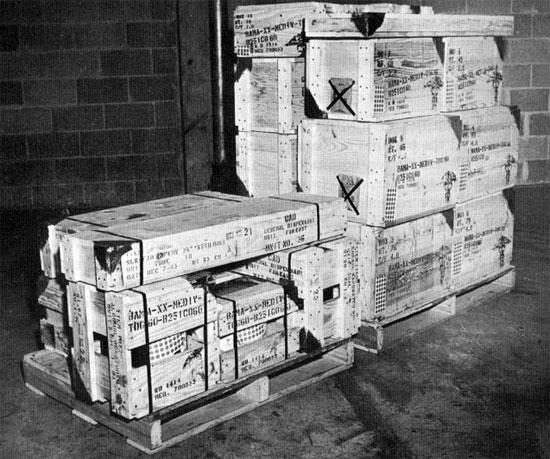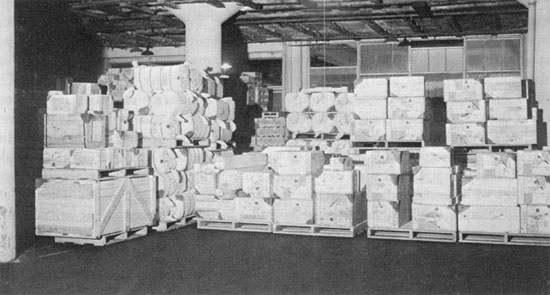Medical Depots in the Zone of Interior

Photograph illustrating the packing room at the Medical Section of the Chicago Quartermaster Depot. Note the varying type of containers used to store supplies.
At the outset of World War II, the Medical Department was responsible for procurement, storage, and issue of approximately 4,500 items. By 1942, the number of items under medical cognizance had jumped to 6,000, and another 1,000 items were added by 1943. During mid-1942, some 700 contractors were serving the Medical Department, but within a year’s time, this had jumped to 2,500 contractors and the number of contracts had reached 25,000.
Aggregating more than 5.4 million square feet by July 1941, Medical Supply Depot space continued to expand after entry of the United States into the war. As more Medical Depots were built in order to accommodate the introduction of the 7,000 additional items required, more depots were opened in July 1942, making the total space available 7 million square feet.

Photograph showing medical supplies, packed in crates ready for shipment from a Medical Depot. Note the use of pallets here, and also the caduceus symbol painted on the crates to the rear, indicating medical supplies are contained within.
Additional space acquisitions increased storage facilities still further during the next 6 months; in July 1943, the peak of 13 million square feet was reached. From this time until the end of the war, the amount of space available was steadily dropping. This was partly as a result of the demand for storage area diminishing. Twenty Depots and Medical Sections had been occupied in July 1943. This number dropped to 17 in July 1944, and to 14 in July 1945. During the same period, the number of square feet occupied fell to 10,348,000 in 1944, and to 9,127,000 in 1945.

A complete outfit for a Station Hospital ready for shipment from a Medical Depot in the Zone of Interior.
The following list is a compilation showing the names and / or locations of the Medical Depots available, their dates of operation, and also their missions. The Medical Depots listed herewith were all based in the Zone of Interior; that is the continental United States of America. The list covers Depots of Medical Sections, General Depots and Medical Depots during the time of 1939 – 1946 (inclusive):
| Name / Location | Date of Activation | Warehouse Storage Space (square feet) | Mission(s) |
|---|---|---|---|
| Atlanta ASF Depot, Medical Section, Conley, Ga. |
1 November 1941 | 681,000 |
|
| Binghamton Medical Depot, Binghamton N.Y. | 9 January 1943 | 618,000 |
|
| Chicago Medical Depot, Chicago, Ill. (Medical Section, Chicago QM Depot). |
April 1942 (Chicago Medical Depot; 10 December 1940) |
576,000 |
|
| Columbus Medical Depot, Medical Section, Columbus, Ohio. |
Before 1939 | 282,000 |
|
| Denver Medical Depot, Denver, Colo. | 1 June 1942 (in 1945 was an ASF, Branch Medical Depot, Class IV for Rocky Mountain Area) |
535,000 |
|
| Kansas City Medical Depot, Kansas City, Kans. | 1 February 1942 | 446,000 |
|
| Los Angeles Medical Depot, Los Angeles, Calif. | 1 June 1942 | 225,000 |
|
| Louisville Medical Depot, Louisville, Ky. | 24 July 1943 (Holding and reconsignment point, 1942; War Aid Depot, 1942; Quartermaster Depot, September 1942; Ordnance depot, 10 October 1942) |
1,713,000 |
|
| Marietta General Depot, Medical Section, Marietta, Pa. | December 1941; closed March 1942 | 175,400 | International Aid Depot. |
| New Cumberland ASF Depot, Medical Section, New Cumberland, Pa. | Before 1939 | 138,000 |
|
| New York General Depot, Medical Section, New York Port of Embarkation, Brooklyn, N.Y. | Before 1939 | 623,700 |
|
| New York Medical Depot, New York, N.Y. (Brooklyn). | 4 July 1941 | 1,964,000 | To receive, warehouse, and ship Medical Depot supplies (see Binghamton Medical Depot for changes). |
| Ogden General Depot, Medical Section, Ogden, Utah. | 15 September 1941 | 294,000 |
|
| Pueblo Ordnance Depot, Medical Section, Pueblo, Colo. | 15 April 1943, and as a sub-depot of Denver, 20 September 1945 | 400,000 | Storage Depot for reserve medical supplies |
| Richmond General Depot, Medical Section, Richmond Va. | 1 June 1941 | 350,000 |
|
| San Antonio Depot, Medical Section, San Antonio, Tex. | Before 1939 (was a QM Depot in 1942) |
306,000 | Distributing Depot for Texas, excluding area by Denver. |
| San Francisco Medical Depot, Oakland, Calif. | 1 July 1942 (in existence before WWII, about 1917) |
714.800 |
|
| Savannah General Depot, Medical Section; ASF in 1943, General Depot 16 May 1943 | 15 January 1941 (sub-depot of Atlanta Medical Section, 1945) | 670,000 |
|
| Schenectady ASF Depot, Medical Section, Schenectady, N.Y. | Before 1939 | 227,000 | Port filler Depot for Brooklyn and New York Ports of Embarkation for drugs, chemicals, biologicals, surgical dressings and supplies for field equipment and special kits. |
| Seattle ASF Depot, Medical Section, Washington. | August 1941 (was a QM Depot with Medical Section established in May 1941) |
300,000 |
|
| Shamokin General Depot, Medical Section, Shamokin, Pa. | 19 July 1941; closed February 1942 | 35,000 | International Aid Depot. |
| Sharonville Engineer Depot, Medical Section, Sharonville, Ohio. | 22 December 1942 | 345,000 | International Aid Depot |
| St. Louis Medical Depot, St. Louis, Mo. | 9 March 1943 (in existence in 1918 or before) | 1,766,000 |
|
| Toledo Medical Depot, Toledo, Ohio. | Before June 1941 (lease executed 10 December, 1940) |
854,000 |
|
| Voorheesville General Depot, Medical Section, Voorheesville, N.Y. | December 1941; closed March 1942 | 43,500 | International Aid Depot. |
